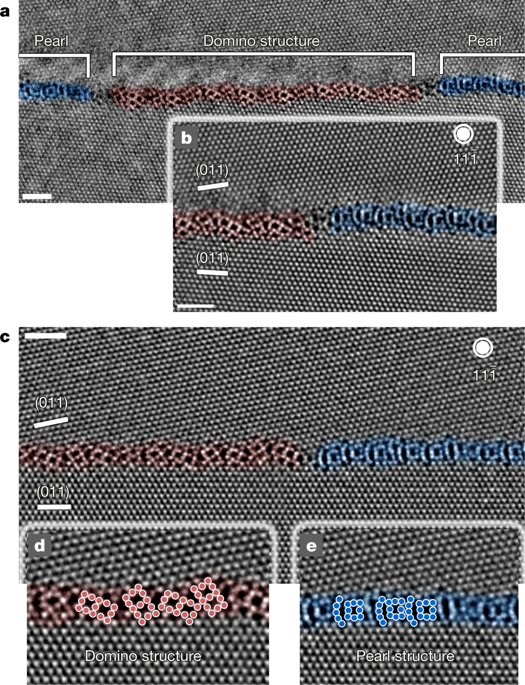Nature ( IF 64.8 ) Pub Date : 2020-03-18 , DOI: 10.1038/s41586-020-2082-6 Thorsten Meiners 1 , Timofey Frolov 2 , Robert E Rudd 2 , Gerhard Dehm 1 , Christian H Liebscher 1

|
The theory of grain boundary (the interface between crystallites, GB) structure has a long history1 and the concept of GBs undergoing phase transformations was proposed 50 years ago2,3. The underlying assumption was that multiple stable and metastable states exist for different GB orientations4,5,6. The terminology ‘complexion’ was recently proposed to distinguish between interfacial states that differ in any equilibrium thermodynamic property7. Different types of complexion and transitions between complexions have been characterized, mostly in binary or multicomponent systems8,9,10,11,12,13,14,15,16,17,18,19. Simulations have provided insight into the phase behaviour of interfaces and shown that GB transitions can occur in many material systems20,21,22,23,24. However, the direct experimental observation and transformation kinetics of GBs in an elemental metal have remained elusive. Here we demonstrate atomic-scale GB phase coexistence and transformations at symmetric and asymmetric \([11\bar{1}]\) tilt GBs in elemental copper. Atomic-resolution imaging reveals the coexistence of two different structures at Σ19b GBs (where Σ19 is the density of coincident sites and b is a GB variant), in agreement with evolutionary GB structure search and clustering analysis21,25,26. We also use finite-temperature molecular dynamics simulations to explore the coexistence and transformation kinetics of these GB phases. Our results demonstrate how GB phases can be kinetically trapped, enabling atomic-scale room-temperature observations. Our work paves the way for atomic-scale in situ studies of metallic GB phase transformations, which were previously detected only indirectly9,15,27,28,29, through their influence on abnormal grain growth, non-Arrhenius-type diffusion or liquid metal embrittlement.
中文翻译:

元素金属中晶界相变的观察
晶界(微晶之间的界面,GB)结构理论具有悠久的历史1,GB 经历相变的概念是在 50 年前提出的2,3。基本假设是对于不同的 GB 方向4,5,6存在多个稳定和亚稳态。最近提出了术语“肤色”来区分在任何平衡热力学性质上不同的界面状态7。不同类型的肤色和肤色之间的过渡已被表征,主要在二元或多组分系统中8,9,10,11,12,13,14,15,16,17,18,19. 模拟提供了对界面相行为的洞察,并表明 GB 转变可以发生在许多材料系统中20,21,22,23,24。然而,GBs 在元素金属中的直接实验观察和转变动力学仍然难以捉摸。在这里,我们展示了元素铜中对称和不对称\([11\bar{1}]\)倾斜 GBs 的原子尺度 GB 相共存和转换。原子分辨率成像揭示了两种不同结构在 Σ19b GB 的共存(其中 Σ19 是重合位点的密度,b 是 GB 变体),与进化 GB 结构搜索和聚类分析一致 21,25,26. 我们还使用有限温度分子动力学模拟来探索这些 GB 相的共存和转变动力学。我们的结果证明了 GB 相如何被动力学捕获,从而实现原子级室温观察。我们的工作为金属 GB 相变的原子尺度原位研究铺平了道路,这些相变以前仅通过它们对异常晶粒生长、非阿伦尼乌斯型扩散或液体的影响而间接检测到9、15、27、28、29金属脆化。



























 京公网安备 11010802027423号
京公网安备 11010802027423号